Railway Age/RT&S 2023 LRT Conference Roundup
Written by David Peter Alan, Contributing Editor, Railway Age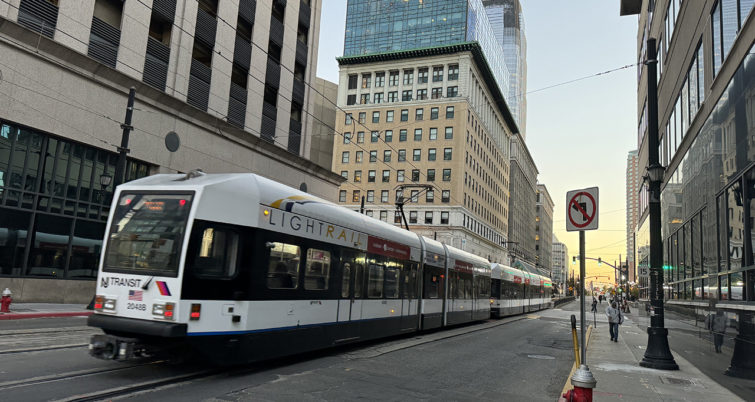
Plans for light rail technology and expansion of existing rail systems dominated a conference with a New Jersey flavor, held in Jersey City and sponsored by Railway Age and its sibling publication Railway Track & Structures (RT&S). The conference took place on Wednesday, November 15 and Thursday morning, November 16, and concluded that afternoon with a tour of New Jersey Transit Hudson-Bergen Light Rail Transit (HBLRT), which now operates in Hudson County with plans to expand northward into Bergen County.
The conference program focused on technology or expansion at New Jersey Transit (NJT), as well as systems in Toronto, Philadelphia, Houston, and the Boston and Seattle areas. While most of the attendees represented companies selling products or services to the industry, agencies from around the United States, as well as Toronto, were also present.
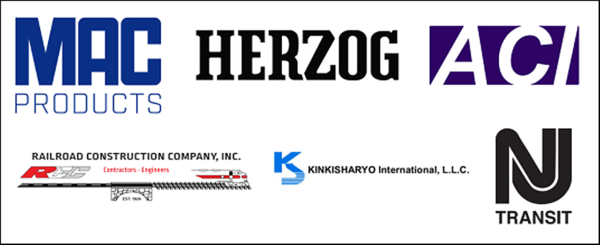
Railway Age Editor-in-Chief William C. Vantuono started the proceedings by introducing the event and its sponsors and mentioning that he traces his interest in rail to his time riding the Newark City Subway in the 1960s as a child with his late father. Originally part of the once-vast Public Service network in the Garden State, the City Subway is NJT’s Newark Light Rail line.
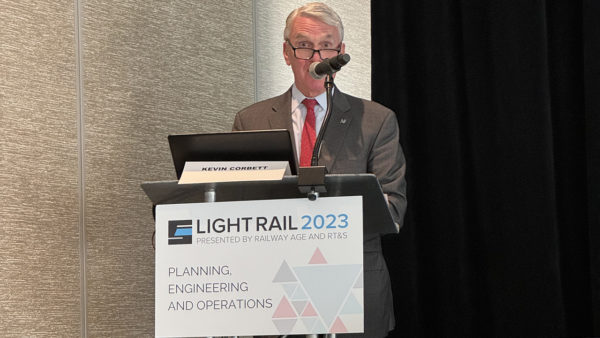
NJT President and CEO Kevin S. Corbett kicked off the conference with the keynote address. He looked back to a time when the agency was “hollowed out and severely underfunded for a decade,” an era characterized by a shortage of engineers and trouble getting Positive Train Control (PTC) installed by the statutory completion deadline. He said, “We’ve come a long way” and mentioned capital projects and the ridership recovery since the COVID virus hit. He noted that rail ridership was back to 70% of pre-COVID levels, while ridership on weekend trains is now at or above pre-COVID levels, an observation also made by reporters and local advocates in other forums. He also mentioned NJT’s three light rail lines, which were discussed in greater detail during the presentations that followed.
Corbett then turned to economic aspects of light rail in New Jersey and described the HBLRT as “one of the largest public works projects in New Jersey.” He said it was the first DBOM (Design, Build, Operate and Maintain) project, which changed the area along the line from “a working waterfront to a development with 10,000 new apartments.” Yet he noted that there was “not one single dollar in value capture” from that development and called for legislation to correct that situation. He mentioned two projects in the works: a one-stop extension of the HBLRT to Route 440 on Jersey City’s West Side and a line between Camden and Glassboro in South Jersey that would connect with the existing River Line between Camden and Trenton. He called for more “accessibility and equity” and more resilience against future storms, as well as technical advances that would turn seats into “mobile data centers.” He concluded by expressing concern about the fiscal cliff that NJT and other providers will face when the federal COVID relief money runs out, a fear also voiced by rider-advocates and some elected officials.
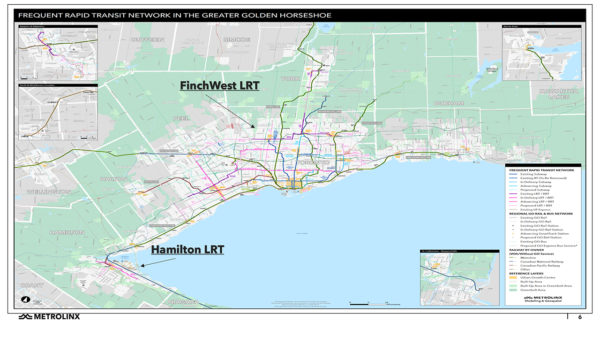
The next presenter was Joseph Costigan, Jr., Senior Manager for Corridor Extensions for the Capital Projects Group at Metrolinx, the provincial agency that providers regional transit in the Toronto area, including the trains on GO Transit. He began by saying that there are 15½ million people living in Ontario and 7 million in the Toronto area, who include about 50% of immigrants who come to Canada. He mentioned lines that will start service in Toronto soon: the Eglinton Crosstown and Finch West lines, and Hurontario, and said that Hamilton will eventually get light rail, too.
Finch West will be a light rail line 6.8 miles long, with 16 stops, and taking 75 minutes for a round trip. It will run with Alstom vehicles, under a DBOM contract and using Communications-Based Train Control (CBTC) technology. Hamilton is a city with a population of about 600,000, located about one hour from Toronto, heading around Lake Ontario toward Buffalo. The Hamilton LRT line is slated to extend 8.7 miles (14 km) between downtown Hamilton and McMaster University, with 17 stations. Costigan said that property values within 300 meters (roughly 1000 feet) of the alignment have increased by 12.3%. He described the history of the streetcars that ran in the city from 1894 until 1951, and added: “We are reinstating sections of the exact alignment that was torn up in ‘51” but also said that the exact scope of the project is still being evaluated.
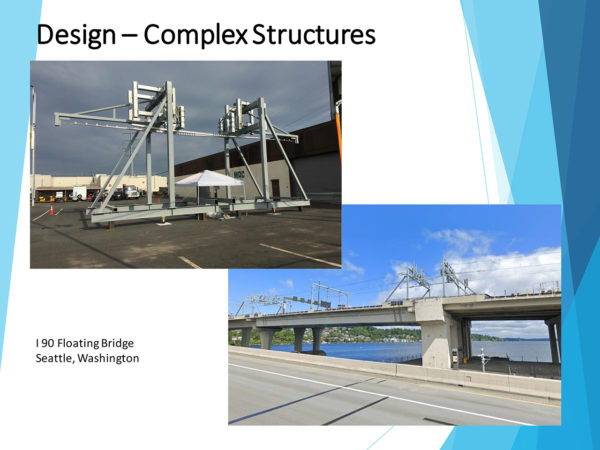
Gary Clarner then introduced the products manufactured by his companies, MAC Products, located in North Carolina. MAC Products, the conference’s Platinum-level sponsor, traces its lineage back to Ohio Brass, which was founded in 1888. It absorbed IMPulse, and Clarner said they fit well together. The company makes rail and electrical distribution equipment, structures, and cantalevers. Its portfolio includes projects for the OKC Streetcar in Oklahoma City, Amtrak, Metro-North, and Houston Metro.
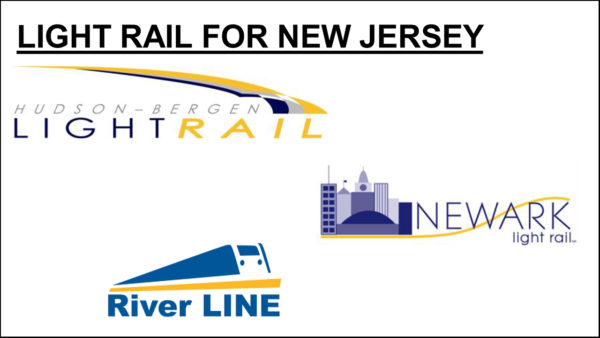
New Jersey Transit was the host agency for the conference, and Chief of Light Rail Operations Gregory Woods described the agency’s three light rail lines: the Newark Light Rail, HBLRT, and River Line in South Jersey, running between Trenton and Camden. Woods had worked for NJT previously from 1998 until 2003 and remarked that he came back last year and “saw a completely different NJ Transit.” He said he saw development and “explosive growth” along the “Gold Coast” in Jersey City, where the HBLRT line runs. At the northern end of that line, though, he lamented that “Bergen County has no [light] rail, after 23 years” since the line was planned, but said it is necessary to start over on the environmental side of permitting. He said that he is looking forward to more express service, like the Bayonne Flyer: limited-stop runs in Jersey City and Bayonne along the HBLRT which operate only during peak-commuting hours, accomplished through careful and precise scheduling. This allows express runs to overtake local ones on the line’s two-track railroad. According to Woods, those runs (on 24-minute headways) save two to three minutes for commuters.
Woods also looks forward to expansions on NJ Transit’s light rail: one stop to Route 440 on Jersey City’s West Side, the long-anticipated northward extension of the HBLRT to Englewood in Bergen County, and a line between Camden and Glassboro (home of Rowan University) in South Jersey. He also mentioned possible service on a Bergen-Passaic line, and the possible conversion of the famous Princeton Dinky to light rail. One technical innovation that Woods mentioned is a “data migration system” that would give supervisors a “dashboard” in real time.
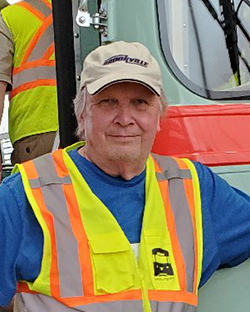
After lunch, the afternoon session began with Vantuono interviewing James C. Greller, a retired planner from NJ Transit, who was on the scene when the HBLRT was planned and built. Greller was Director of Rail Transit Development at NJT, and has written extensively about electric trains and rail transit. He remembered the 1980s “Circle of Mobility” campaign led by then-governor Thomas Kean, Sr., which included a light rail line between Jersey City and a park-and-ride lot on the New Jersey Turnpike. Although Greller’s magazine, Electric Lines, promoted electrified rail transit, he told the conference that “light rail was sort of a boutique idea” and that the people on the scene at the time had “no idea about moving people.” In effect, he said, “‘Light rail’ was a new name for ‘trolley cars’” but the audience at the conference at the time the idea was introduced started applauding at the mention of it. He added that it was then up to NJT to pay for the line. Greller recalled that his experience publishing Electric Lines gave him credibility with transportation staffers in Washington, D.C., and New Jersey officials were eventually won over, so they made a DBOM arrangement and eventually extended the line to Bayonne.
Next on the program was a panel about new starts, regulations, and temporal separation, titled Engineering for Operations. The moderator was Alfred E. Fazio of BRT Rail Services, a longtime engineer, planner and manager, and also a Contributing Editor at Railway Age. His recent article about the HBLRT: Hudson-Bergen Light Rail: DBOM and More, which ran in the November issue of Railway Age and was posted on the Railway Age website on November 10, is a cautionary tale about working with contractors, especially large firms. He began his presentation by saying that light rail started in Brooklyn in 1910, when the Brooklyn Rapid Transit (BRT, predecessor to the better-known BMT), put shoes, traps and trolley poles on trains. The subject then turned to regulation and temporal separation.
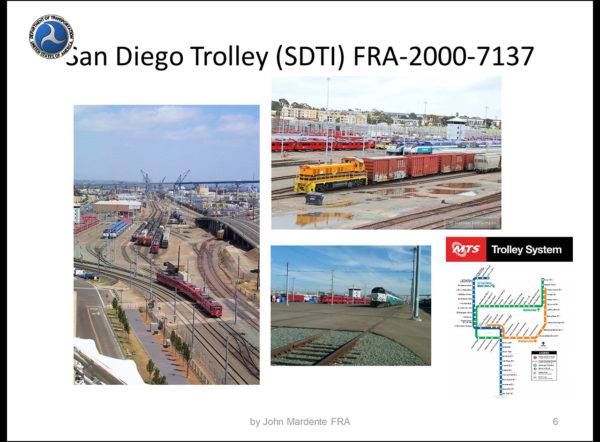
John Mardente of the FRA Office of Safety, Assurance, and Compliance gave a detailed presentation on those topics and associated best practices. He started by saying that he had spent 20 years at the agency but had started with New York City Transit. For a shared-track operation with freight and rail transit, he stressed the need for waivers, and for a Memorandum of Understanding (MOU) that clarifies exclusive blocks of time for the freight and passenger operations. He then explained several varieties of temporal separation operations, with examples of each. He said that petitions for shared-track operations must be specific, and that railroad people know what is needed. He added that the River Line in South Jersey is a complicated arrangement, with NJT running the rail transit and Alstom running the freight side under NORAC rules. He concluded by saying that safety is not negotiable, and that all petitions to the FRA Safety Board for waivers are different. He did say that “Alternate Vehicle Technology” under 49 C.F.R. Part 238 could allow some transit operations on shared track, including TEXRail in Fort Worth and the Arrow trains between Redlands and San Bernardino, California (where some connect with Metrolink).
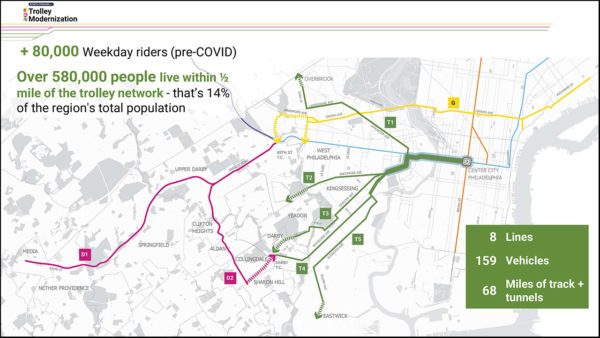
Anna Hooven, Trolley Maintenance Program Manager at SEPTA in Philadelphia, began her presentation by describing the history of the city’s streetcars and the network SEPTA operates today. She referred to current operating conditions as “constraints and challenges” and called for uniform goals, traffic signal priority for the cars, and cars that are “accessible, fast, and easy” with a “universal design.” Most of the cars on SEPTA today were made by Kawasaki in the 1980s, but longer (86-foot) vehicles with low-floor boarding will be built by Alstom. Some of the changes that Hooven said are in store at SEPTA are accessible stations, fewer stops (every other block), all-door level boarding and a POP (proof-of-payment) system to replace on-board fare collection. She added that the system will be upgraded one line at a time, with substitute busing while each line is under construction. The improvements will include bridge upgrades for the heavier vehicles that are coming, power upgrades, and track deviation routes. There are also plans to build a new maintenance facility.
Fazio then returned with a description of how the Bayonne Flyer runs on the HBLRT operate. The current schedule calls for skipping stops on both sides of the Liberty State Park stop, in the middle of the line. With precise scheduling and operation, “Flyers” overtake all-stops local runs with cars on both tracks running in the same direction on portions of the route. He said: “People do not ride by distance. They ride by time and security” and that saving two or three minutes is important to regular riders.
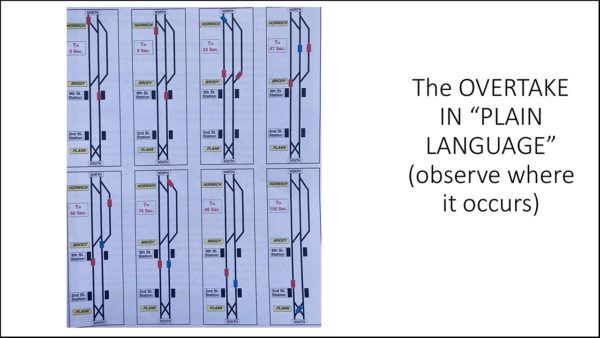
There is also “Three Roads,” a short three-track segment north of Hoboken, where Fazio described how overtakes are staged. They are set up on the three-track segment, but they occur on a two-track segment immediately north or south of it. He said that pairs of parallel moves at the wye optimized with asymmetrical headways make the overtakes possible, and showed a video that depicted the operation.
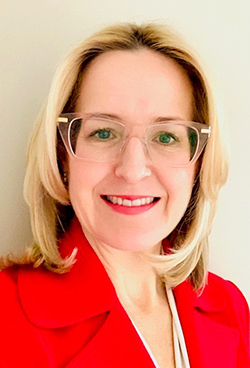
After a coffee break, Catherine Campbell-Wilson, Vice President for Strategy and Growth at Bechtel, gave her views on Innovative Project Delivery Methods. She concentrated on project delivery models for mega-projects like tunnels, which involve a large scope of work and high costs. She mentioned procurement models, construction management, new project-centered organizations, including the possibility that they could be multi-jurisdictional in scope.
Wilson concentrated on the use of a “delivery partner” beginning early in the process. That entity could help coordinate the many activities involved in building a project, such as contracting, coordinating the activities of consultants, scheduling, and getting “real time” data. She stressed that an owner needs to work with the delivery partner to establish a collaborative approach with contractors and incentivize behaviors through coaching sessions with teams and similar activities. In addition, she cautioned against “optimum bias” around scheduling and discounting the likelihood of risk to prompt completion.
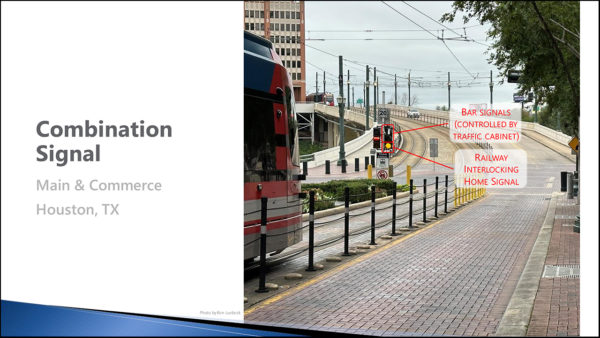
Next on the program was a panel from Houston Metro, about the technical aspects of Unified Signals for Street-Running LRT. The main theme of the session was integrating traffic signals with railroad interlockings for the rail line. Ken Luebeck, a Public Project Manager for Benesh who had worked on projects at Metro, described several different types of signal configurations, while saying that attempting to integrate the two was like attempting to force the proverbial round peg into a square hole. He also described the current Houston system, which combines rail and auto signals as a married pair.
Fred Mills, Chief Signal Engineer at Metro, described integration with the software in use at the agency, where the railway signal can override the traffic signal, and the conditions under which that event occurs. Giuseppe Mattoscio, Metro’s Chief Safety Engineer, described the agency’s SMS (Safety Management System), operated under 49 C.F.R. §673. He discussed unified signal prototypes and gave examples of special operations, where emergency vehicles have priority over rail and other vehicles.
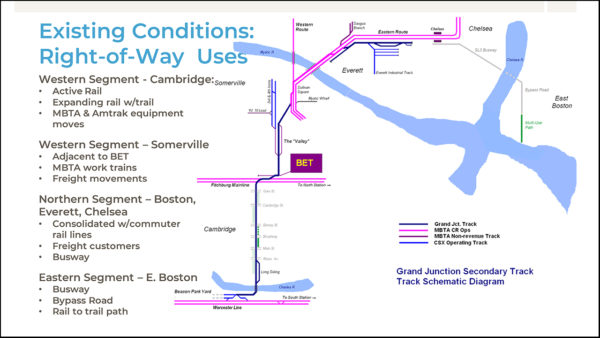
The Thursday session lasted until late in the morning and included two presentations before the closing panel. The first came from Rachel J. Burkhardt, a Boston-based Assistant Vice President and Senior Project Manager for WSP USA and focused on the MTBA’s Grand Junction Rail Study. Grand Junction is the connection point between the former Boston & Albany Railroad (B&A) and North Station, the hub for Northside service on the MBTA (the “T”) and Amtrak’s Downeaster trains to Portland and Brunswick, Maine. The former B&A line hosts trains on the T to Framingham and Worcester and the Massachusetts section of Amtrak’s Lakeshore Limited, all of which now terminate at South Station. The junction is used occasionally for equipment moves, but proposed full-service use could add flexibility.
Burkhardt had conducted her own self-published study to promote this example of what she called “circumferential transit” in 2016, and another for the Cambridge Redevelopment Authority (CRA) earlier in 2023. She noted that the line at issue had been a heavily used industrial line in the past, but MassDOT had purchased it from CSX, although MIT still owns some of the right-of-way behind its campus and Kendall Square. The proposal would run essentially from the old Beacon Park Yard in Allston and under MIT to North Station. Alternatives included such an operation as part of the T’s regional rail network, a branch of the Red Line subway, buses, or a shuttle terminating at Kendall Square. There was also a proposal to build a new “West Station” on the way to North Station.
The proposal could work with regional rail or transit equipment, but the latter would not be FRA-compliant. Burkhardt proposed operating like light rail, but with FRA-compliant equipment, saying that there is equipment available that could run with emerging battery technology or straight electric. The line would be roughly 4½ miles long and could be operated on 15-minute headways with four trainsets, although two more would be needed for spares.
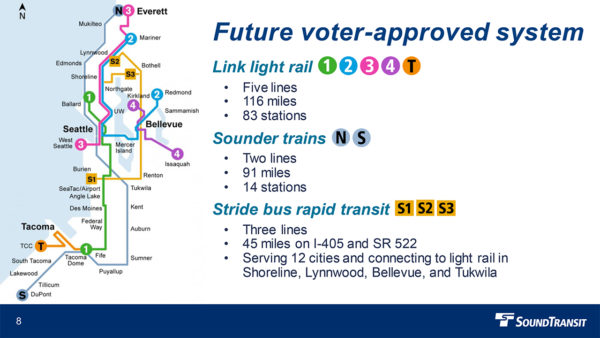
The final presenter before the closing panel was Suraj Shetty, Executive Director of Operations for Sound Transit, who focused on the agency’s Light Rail Expansion Program in the Seattle area. He started by describing the three counties in Sound Transit’s service area: Snohomish (north of Seattle, including Everett), King (the city of Seattle), and Pierce (south of Seattle, including Tacoma). He said that 40% of Washington State’s population lives there, and that the three counties also run their own transit systems within county borders. Sound Transit started by building and running light rail between downtown Seattle and SEA-TAC Airport, added Sounder trains north of Seattle to Everett and south to Tacoma and Lakewood, then added intercounty buses, and later expanded those service lines. There are plans to add three more “Link” light rail lines and extend Sounder trains both north and south by 2044.
Plans for the near future include East Link light rail between Redmond and Bellevue in 2024, with an extension over a floating bridge to open in 2025. There are also plans to go south to Linwood in 2024, and along Federal Way between the airport and Tacoma in 2026. Tacoma Link (a/k/a the “T Line”), a now-isolated line in Tacoma, was extended by 2.4 miles from its original 1.6, on September 16, 2023.
Shetty then gave an overview of the Operations Department, along with facilities and system maintenance. He described how authority over a new segment transition from construction to Operations, and a ten-year project-development lifecycle for new extensions. That included a description of how the rail activation team works alongside bus managers, the FTA, local officials and the counties until the project team can turn control of the project over to Operations.
The final event of the conference was a panel of journalists, announced as A General Discussion of LRT’s Role in Public Transportation and led by Railway Age Editor-in-Chief William C. Vantuono. The other panelists were RT&S Editor-in-Chief David Lester and this writer. Vantuono started the discussion by telling about his relationship with Railway Age and saying that he wanted the session to be interactive. It was, including questions and comments from the audience, although some of the discussion went beyond the confines of a strict limitation to the subject of light rail. Lester had not presented previously at the conference, and he introduced himself and his publication, which historically concentrated on civil engineering for rail. He added that he has own background in IT, and that the pieces in his publication should be of interest to anyone who works for a railroad.
Vantuono raised the issue of ridership and scheduling in what everybody hopes will be the post-COVID era. He noted that ridership on light rail is recovering well in many places, but that does not necessarily hold for other modes, also mentioning that traditional commuting has not returned to pre-COVID levels, so the agencies that run the trains might have to adjust their schedules to the new ridership patterns. Lester stated his concern about the ripple effects from a reduced number of riders going to downtown offices as often as they did before the virus struck, like lower office rents and declining downtown real estate markets, and he posed the question of how long they could remain viable.
Regarding vehicles, Vantuono raised the possibility of a session on new vehicle technology at next year’s conference. He mentioned some of those technologies, specifically charging systems for battery-powered light rail vehicles and third rails buried underground with inductive pickup for power. John Mardente from the FRA said that his agency is open to new technology, especially on issues concerning safety. On other policy matters, Vantuono brought up FTA involvement, along with the FRA’s New Starts Division, which also works with the FTA. Another FTA initiative he mentioned is funding to keep transit infrastructure in a state of good repair, to help ensure a safe ride for all riders. Lester, who is from Atlanta, mentioned a problem encountered by persons and organizations attempting to grow transit outside the East, where transit is strong: that motorists generally and elected officials need to deal with fear of riding transit, which could prevent many motorists from giving transit a try. On the other hand, Vantuono mentioned that young people are not as interested in driving vehicles as much as their elders are, so they could be attracted to using rail transit.
I added a few observations from data I had compiled before the conference. There were more than three times as many attendees who were either from the “supply industry” (including consultants) at the event than there were from agencies which could purchase such goods or services. Expansion of rail transit in the United States has been slow since the virus hit, eight new segments opening in the past four years, for an average of two per year. There are a few new starts in Canada, too, and there should be more next year. The pace of new rail starts appears to be slowing, though. Of 64 applications for “new starts” now before the FTA, only 25 request funding for rail projects, less than 40% of the total.
Lester mentioned that some federal funding is used for research equipment, signal systems, and similar purposes. His two questions were “What does it do to help you operate better?” and “How does it help you attract riders?” two questions that will assume increasing importance as funding could become an existential issue for transit providers. The federal COVID relief money that has kept the operating side of many transit agencies going for the past few years will run out for many of those agencies in a year or two. Lester raised the issue, asking “How do you plan for this?” and I took it further, expressing concern that, with the continuing emphasis on funding for capital projects at the FTA and no provision for operating support as a permanent part of the funding mix, the time could come soon when transit providers would be able to afford to build expensive infrastructure, but could not afford to operate on it.
The conference ended about noon on Thursday, and several participants grabbed a box lunch and headed toward the HBLRT station at Exchange Place for a ride on the line and a tour of its control facility. Thus ended a conference sponsored by two Simmons-Boardman Rail Group publications, which presented a range of topics about light rail generally, technology, service expansion on several modes, and a bit of policy.
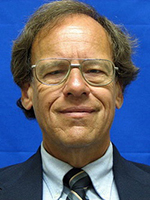
David Peter Alan is one of America’s most experienced transit users and advocates, having ridden every rail transit line in the U.S., and most Canadian systems. He has also ridden the entire Amtrak and VIA Rail network. His advocacy on the national scene focuses on the Rail Users’ Network (RUN), where he has been a Board member since 2005. Locally in New Jersey, he served as Chair of the Lackawanna Coalition for 21 years, and remains a member. He is also Chair of NJ Transit’s Senior Citizens and Disabled Residents Transportation Advisory Committee (SCDRTAC). When not writing or traveling, he practices law in the fields of Intellectual Property (Patents, Trademarks and Copyright) and business law. Opinions expressed here are his own.





